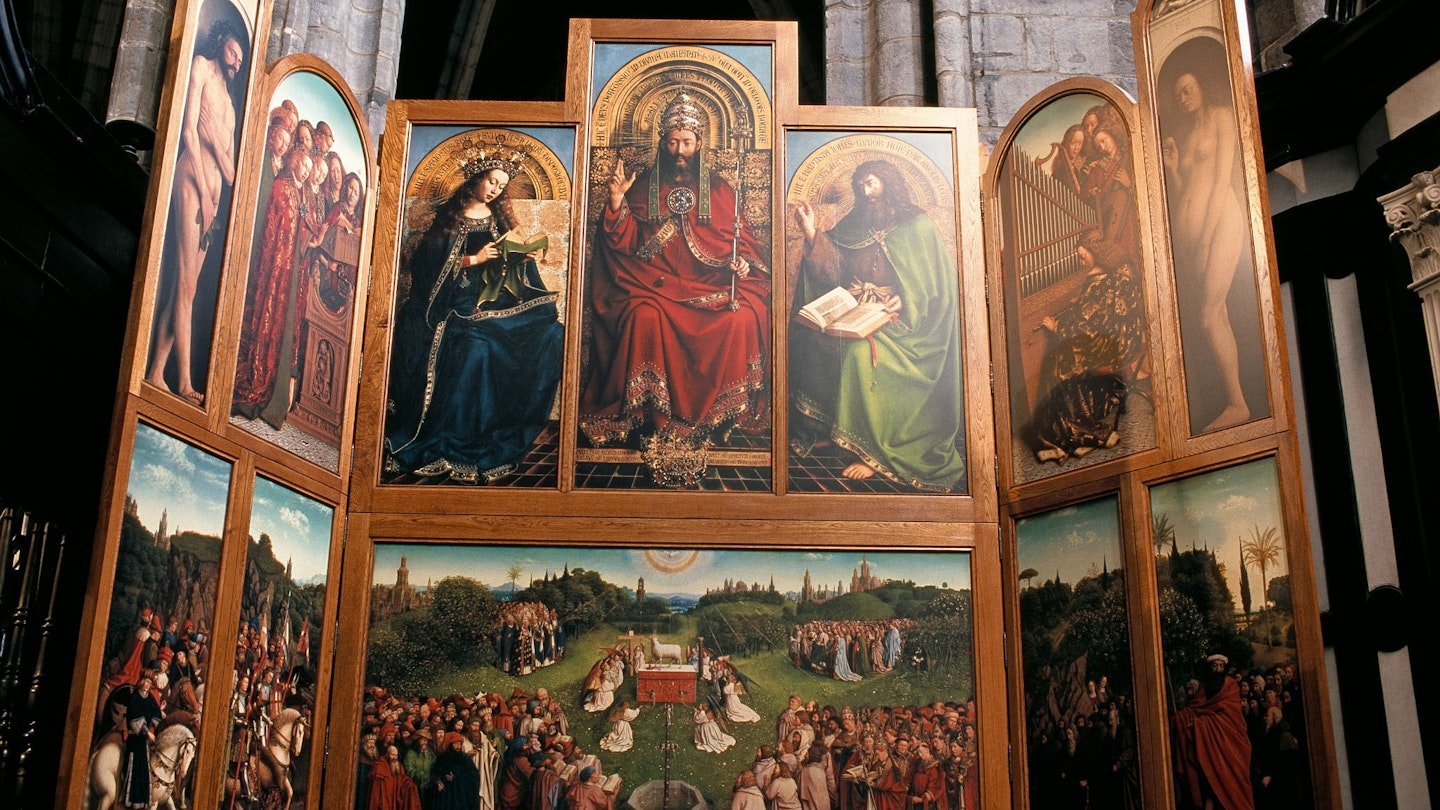The Ghent Altarpiece
The Belgian city of Ghent is associated with many wonderful creations: it even claims to have invented waffles. Its icon, though, is Jan van Eyck’s Ghent Altarpiece, also called Adoration of the Mystic Lamb (Het Lam Gods in Flemish). In 2020, the city is focused on this magnificent painting, the highlight being a blockbuster exhibition called Van Eyck: An Optical Revolution (until 30 April).
What is the Ghent Altarpiece?
The Ghent Altarpiece is an enormous painting displayed in St Bavo Cathedral. The painting is a triptych: an altarpiece with a large central section and two “wing” sections on hinges, allowing the altarpiece to be opened or closed. Some panels are painted on both the front and back. The painting was initiated by Hubert van Eyck in 1426, but sadly, he passed away that same year, leaving his younger brother Jan to complete it in 1432.
Why is the Ghent Altarpiece so important?
The Ghent Altarpiece is packed with significance. It was the first realist-style painting and the first great oil painting. It can be argued that it is among the most influential paintings ever created; upon its completion, it gained prominence throughout Europe, becoming a pilgrimage site for artists and art lovers, and establishing oil painting as the preferred medium for the subsequent 500 years. However, it is also the most frequently stolen artwork in history, facing numerous adversities including theft, fires, and wars.
If you are visiting Ghent, a fantastic way to explore the city is by following the sites linked to the painting. This walking tour allows you to visit key locations in the history of the Ghent Altarpiece, including a panel that was stolen in 1934 and remains missing. Who knows: if you keep your eyes open, perhaps you’ll uncover its whereabouts!
MSK
The MSK (Fine Art Museum of Ghent) hosted the Van Eyck exhibition in 2020 and was the site of the restoration of the altarpiece from 2012 to 2019. Here, conservators painstakingly removed layers of paint and varnish that post-dated Van Eyck, significantly altering the interpretation of this renowned painting by art historians. You can also see other works by Van Eyck, as well as masterpieces by other Belgian artists like Brueghel and Magritte.
Monument to the Van Eyck Brothers
The 1913 World Fair was held in Ghent, and a bronze statue group was created to commemorate the Van Eycks. Hubert remains a somewhat obscure figure, with no confirmed paintings attributed to him, while Jan is celebrated worldwide. In fact, Hubert’s legacy came to light only when an inscription was found during the restoration of a panel, which stated that the masterpiece was initiated by Hubert and completed by Jan, referred to as “second in art”—a testament to Hubert’s enduring influence.
Gravensteen
On 19–20 April 1566, Calvinist rioters set out to destroy the altarpiece as a symbol of Catholicism. Local Catholics safeguarded it, disassembling it and hiding its panels in St Bavo Cathedral’s bell tower. While the elaborate frame was destroyed, most of the artwork survived. Following the riots, it was relocated to Gravensteen, a sturdy fortress in the city, for protection until the Calvinist threat diminished.
Episcopal Palace
During WWI, German forces coveted the Ghent Altarpiece for its symbolic value as Belgium’s greatest treasure. As the army advanced, a courageous local canon, Gabriel van den Gheyn, cleverly disassembled the altarpiece and concealed the panels by loading them into a junk seller’s cart adjacent to the Episcopal Palace. The panels remained hidden in private homes until the Germans were ultimately defeated.
St Bavo Cathedral
Despite a tumultuous 600-year history, the Ghent Altarpiece remains mostly intact and is on display in the cathedral. All of the original panels can be viewed here, except one; the missing panel, known as the Righteous Judges, was stolen in 1934 during a heist orchestrated by stockbroker Arsene Goedertier, who hid it inside the cathedral. He attempted to negotiate a ransom but died before arriving at a settlement. A copy of this missing panel is displayed alongside the 11 original panels of the altarpiece.
Augustinian Monastery
The location of the original Righteous Judges panel remains a mystery, but its journey has been traced to various locations. Initially hidden in St Bavo Cathedral, it eventually caught the attention of Nazi officials, including Joseph Goebbels, who aimed to present it to Hitler. A Nazi art detective allegedly discovered it hidden under stairs in the cathedral, but it was spirited away just in time. Reports suggest it was next hidden in the nearby Augustinian Monastery, concealed behind the first confession booth on the left as you enter.
Church of St Gertrude (Wetteren)
The panel was later moved from the Augustinian Monastery, spending a lengthy period hidden behind the altar screen at the parish Church of St Gertrude, located just outside Ghent. It remained undisturbed for such an extended period that dirt settled around it, leaving an outline of the missing panel that can still be seen today.
Kalandeberg Square
Efforts to locate the missing panel continue, with Ghent police considering numerous tips regarding its whereabouts each year. In 2018, they investigated a lead suggesting that the panel was buried beneath Kalandeberg Square, but nothing conclusive was found. Consequently, police issued a notice urging overzealous residents to refrain from digging. Other recent probes have included searching under the floorboards of private residences and excavating parking garages.





